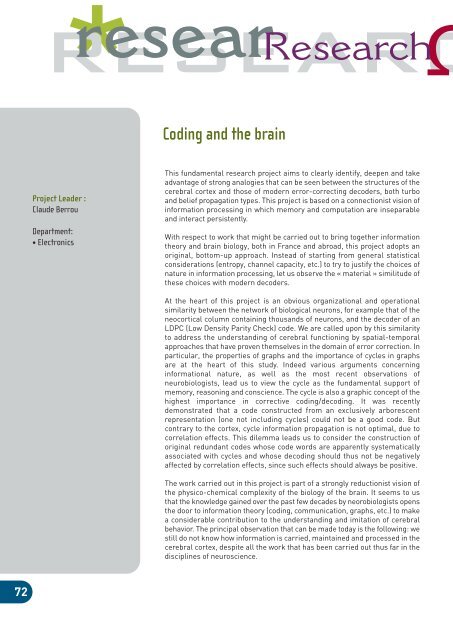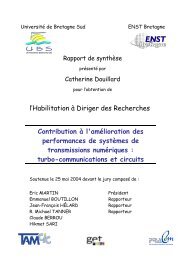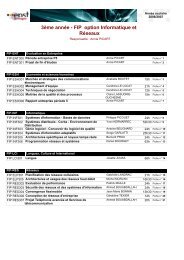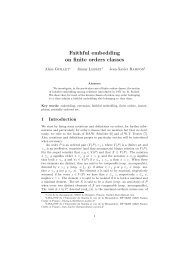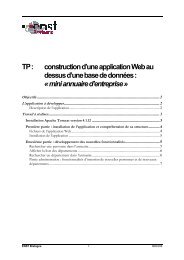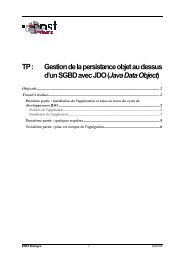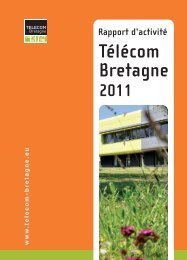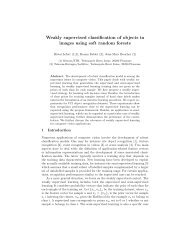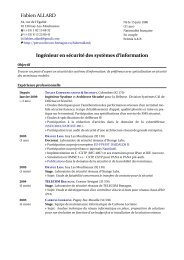researResearch - Télécom Bretagne
researResearch - Télécom Bretagne
researResearch - Télécom Bretagne
Create successful ePaper yourself
Turn your PDF publications into a flip-book with our unique Google optimized e-Paper software.
esearc<br />
<strong>researResearch</strong><br />
Coding and the brain<br />
Project Leader :<br />
Claude Berrou<br />
Department:<br />
• Electronics<br />
This fundamental research project aims to clearly identify, deepen and take<br />
advantage of strong analogies that can be seen between the structures of the<br />
cerebral cortex and those of modern error-correcting decoders, both turbo<br />
and belief propagation types. This project is based on a connectionist vision of<br />
information processing in which memory and computation are inseparable<br />
and interact persistently.<br />
With respect to work that might be carried out to bring together information<br />
theory and brain biology, both in France and abroad, this project adopts an<br />
original, bottom-up approach. Instead of starting from general statistical<br />
considerations (entropy, channel capacity, etc.) to try to justify the choices of<br />
nature in information processing, let us observe the « material » similitude of<br />
these choices with modern decoders.<br />
At the heart of this project is an obvious organizational and operational<br />
similarity between the network of biological neurons, for example that of the<br />
neocortical column containing thousands of neurons, and the decoder of an<br />
LDPC (Low Density Parity Check) code. We are called upon by this similarity<br />
to address the understanding of cerebral functioning by spatial-temporal<br />
approaches that have proven themselves in the domain of error correction. In<br />
particular, the properties of graphs and the importance of cycles in graphs<br />
are at the heart of this study. Indeed various arguments concerning<br />
informational nature, as well as the most recent observations of<br />
neurobiologists, lead us to view the cycle as the fundamental support of<br />
memory, reasoning and conscience. The cycle is also a graphic concept of the<br />
highest importance in corrective coding/decoding. It was recently<br />
demonstrated that a code constructed from an exclusively arborescent<br />
representation (one not including cycles) could not be a good code. But<br />
contrary to the cortex, cycle information propagation is not optimal, due to<br />
correlation effects. This dilemma leads us to consider the construction of<br />
original redundant codes whose code words are apparently systematically<br />
associated with cycles and whose decoding should thus not be negatively<br />
affected by correlation effects, since such effects should always be positive.<br />
The work carried out in this project is part of a strongly reductionist vision of<br />
the physico-chemical complexity of the biology of the brain. It seems to us<br />
that the knowledge gained over the past few decades by neorobiologists opens<br />
the door to information theory (coding, communication, graphs, etc.) to make<br />
a considerable contribution to the understanding and imitation of cerebral<br />
behavior. The principal observation that can be made today is the following: we<br />
still do not know how information is carried, maintained and processed in the<br />
cerebral cortex, despite all the work that has been carried out thus far in the<br />
disciplines of neuroscience.<br />
72


